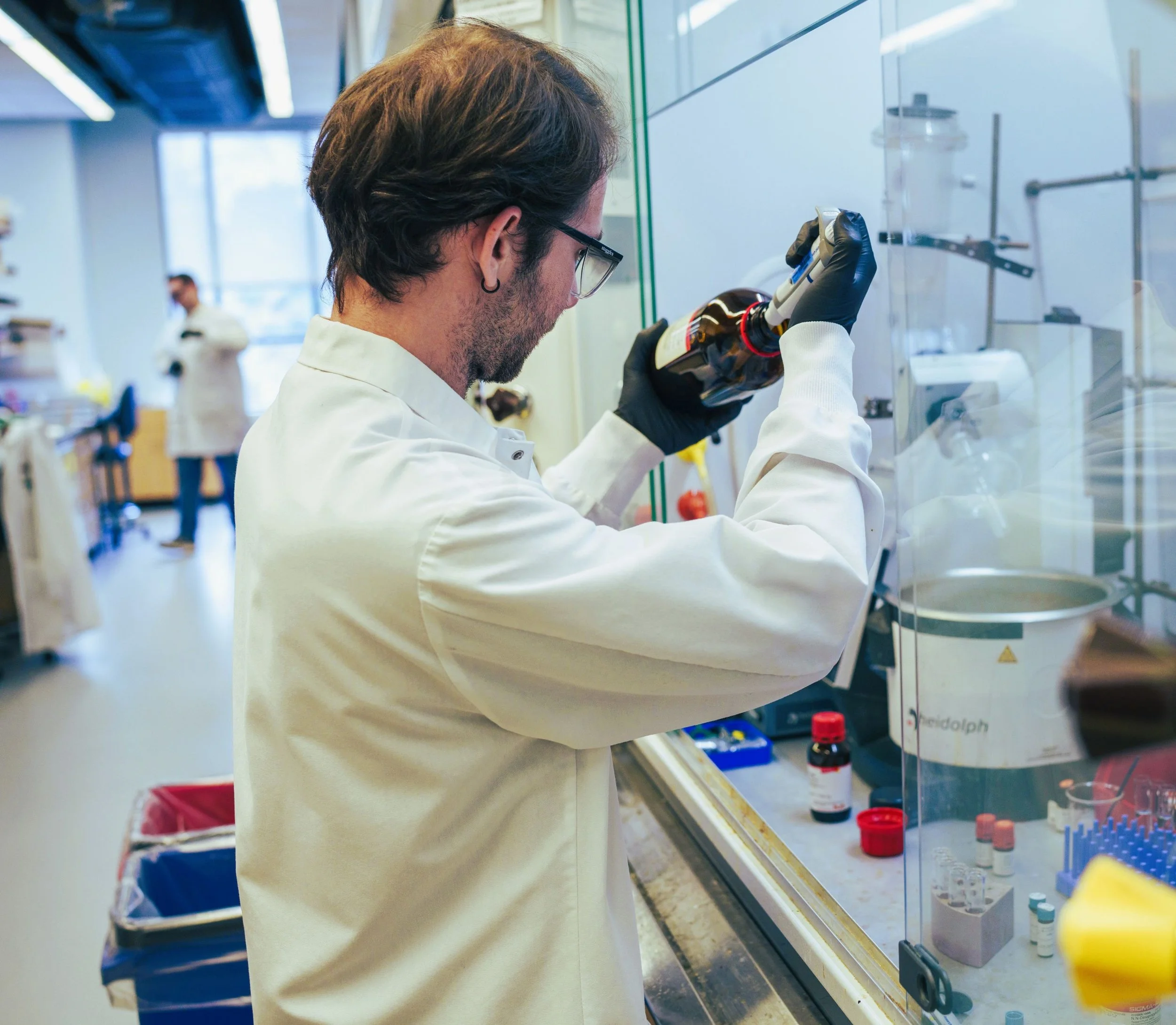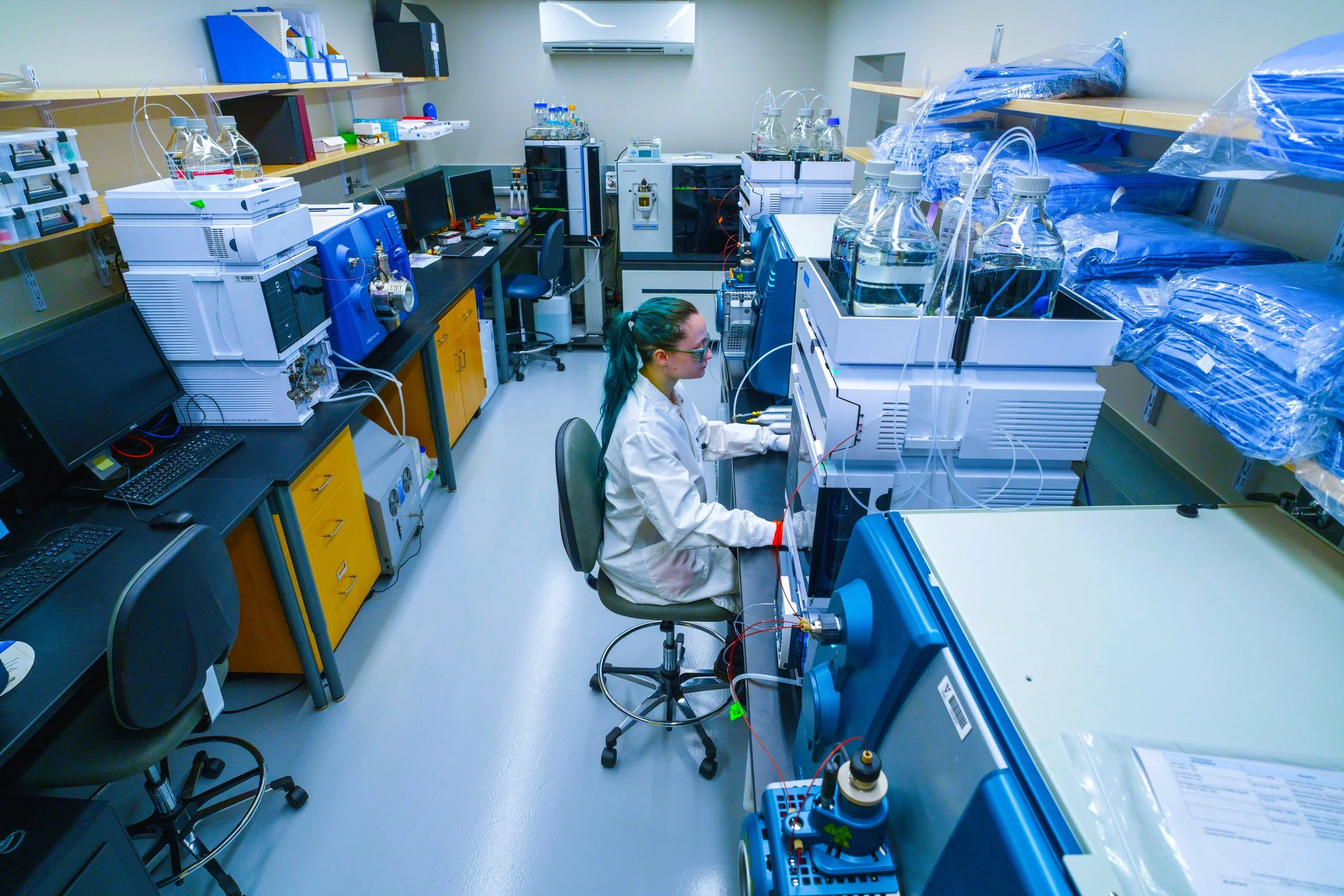
Discovery Teams
At the Warren Center for Neuroscience Drug Discovery, our Discovery Teams form the backbone of our translational research efforts. These highly collaborative groups—spanning medicinal chemistry, molecular pharmacology, DMPK, and behavioral pharmacology—combine deep expertise with advanced technologies to drive every stage of the drug discovery process. From target validation to in vivo proof of concept, our integrated approach allows for rapid iteration and seamless progression toward clinical candidates.

Medicinal Chemistry
Objective:
Our exceptional team of medicinal chemists utilizes the latest innovations in modern synthetic and medicinal chemistry to rapidly develop small molecule probes for biological systems. We excel at developing chemical matter for all stages of the drug development pipeline, from early discovery to IND-enabling studies, and commit to sharing any high value tool compounds for use by the broader scientific community.
-
Matrix/Parallel Library Synthesis – over 21,000 building blocks in-house
State of the Art Modern Synthetic Technologies
4 Automated Biotage Initiator+ microwave synthesizers
HepatoChem Photoredox boxes
IKA ElectraSyn 2.0 Electrochemistry apparatus
High-Throughput Automated Purification Platforms
5 Gilson Reverse-Phase High-Performance Liquid Chromatography Systems (milligram to gram scale)
2 Biotage Isolera One Normal-Phase Chromatography Systems
8 Teledyne ISCO CombiFlash Rf+ Normal-phase and Reverse-Phase Chromatography Systems
Supercritical Fluid Chromatography (SFC)
Thar Investigator analytical SFC for chiral screening
Pic Solutions SFC-PicLab-Prep-100 for large-scale chiral resolutions
Analytical Technology
5 Waters LCMS
Quadrupole time-of-flight (Q-TOF) for High Resolution Mass Spectrometry
Solubility Assays
Cheminformatics and Data Management Platform
Dotmatics Database Platform
-
Drug Discovery Efficiency
All electronic notebooks, plus chemical, analytical, pharmacology and DMPK data/reports are collated in a centralized database to maximize efficiency and productivity.
This platform allows collaborators to see real-time data as it is generated.
Newly generated compounds are tested in pharmacology, physicochemical and DMPK assays in-house with a typical 2 week turnaround time.
This cohesive workflow rapidly informs future SAR development and allows for project goals to be achieved in desired timelines.
Intellectual Property (IP)
Discovery and development of novel chemical scaffolds has resulted in hundreds of patent applications and issued patents

Molecular Pharmacology and Biology
Objective:
Provide primary screening, assay development, high-throughput screening (HTS) and detailed in vitro pharmacological analysis of small molecule ligands.
-
Hamamatsu FDSS (µCell) screening platform
Agilent BRAVO liquid handlerBeckman Coulter ECHO 650 acoustic liquid handler
EnVision 2105 Multimode Microplate Reader
Ca2+ mobilization fluorescence assay
GIRK/Thallium Flux assay
Radioligand displacement assays
-
Dotmatics Knowledge Solutions for cloud-based analysis and storage of assay data.
Triplicate Screening technology to capture 3 modes of ligand pharmacology in one 4 min assay.
Weekly data generation and reporting to inform SAR for the next round of screening.

Drug Metabolism and Pharmacokinetics (DMPK)
Objective:
Support the WCNDD’s drug discovery efforts by providing comprehensive in vitro and in vivo ADME (Absorption, Distribution, Metabolism, and Excretion) services, including metabolic stability, protein binding, permeability, CYP inhibition, pharmacokinetics, and human dose prediction.
Establish a DMPK team with capabilities uncommon in academic settings, modeled after the structure and efficiency of a mid-sized biotech company.
Deliver full in vitro and in vivo ADME profiling to de-risk preclinical candidates and facilitate early “Go/No-Go” decisions.
Understand mechanisms of drug clearance and pharmacokinetic/pharmacodynamic (PK/PD) relationships to maximize on-target efficacy.
-
The primary goal of in vitro ADME (Absorption, Distribution, Metabolism, and Excretion) studies is to evaluate the pharmacokinetic properties of drug candidates early in the development process. These studies help predict how a drug will behave in the human body, guide chemical optimization, and assess potential drug-drug interactions, ultimately aiding in the selection of viable candidates for further investigation.
Protein Binding (Plasma and Brain Homogenate)
Metabolite Identification (MetID) Assay (HLM or Hepatocytes)
-
The main aim of in vivo DMPK (Drug Metabolism and Pharmacokinetics) studies is to assess how a drug behaves within a living organism, typically animal models. These studies provide crucial insights into absorption, distribution, metabolism, and excretion profiles under physiological conditions, helping predict human pharmacokinetics and supporting dose selection and safety evaluations for clinical trials.
Rat IV PK PBL Cassette
Rat IV PO PK discrete studies
Rat/Mouse PO PBL exposure studies
NCA Analysis
PK/PD relationship studies (Rat and Mouse)
MED and MTD to establish therapeutic index
-
Liquid handling and robotization streamline workflows by automating repetitive tasks, such as sample preparation and reagent dispensing, reducing manual labor and minimizing errors. These technologies enable higher precision and consistency, allowing researchers to process larger sample volumes in less time. At the WCNDD, we use the following equipment.
Triple Quad 4500 mass spectrometers
Qtrap 5500 and 6500+ mass spectrometers
Sciex Automated MRM Discoverer software
Orbitrap Thermo Lumos Fusion mass spectrometer
Tecan Evos liquid handler
Agilent Bravo with BenchCel workstation
Beckman Echo 650 liquid handler
-
First-in-human dose prediction involves integrating data from preclinical studies to estimate a safe starting dose for clinical trials. This involves analyzing pharmacokinetics, pharmacodynamics, and toxicity profiles from in vitro and in vivo studies, and scaling doses to humans using allometric or physiological models.
Allometric scaling
IVIVE

Behavioral Pharmacology
Objective:
Provide pharmacological characterization of small molecule ligands in established preclinical models of central nervous system (CNS) disorders including schizophrenia (Sz), Parkinson’s Disease (PD), dystonia, and Alzheimer’s Disease (AD)
-
Assay evaluating antipsychotic-like activity: Amphetamine- or MK-801 Induced hyperlocomotion, PPI, CAR
Assays to assess cognitive function: NOR, conditioned fear, RAM, MWM
Assays to evaluate efficacy in movement disorders: HIC, 6-OHDA lesion forelimb asymmetry, rotarod, automated gait analysis
Assays to evaluate pain: von Frey, Hargreaves, formalin test
Assays to assess addiction: Self administration, CPP
Genetic/humanized rodent models of Alzheimer’s disease
Dosing/collection of in life PK samples for DMPK
-
Develop strong pharmacokinetic/pharmacodynamic relationships in various animal models for GPCRs and related targets.
Support biomarker strategies (i.e. EEG, phMRI, PET) in preclinical models.
Evaluate early stage, preclinical toxicology and safety pharmacology for pre-IND candidates.




